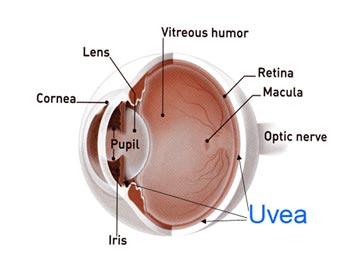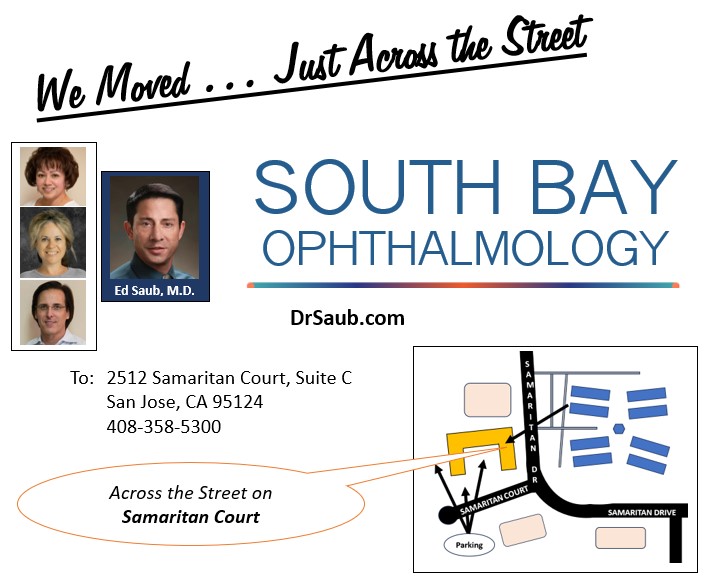Uveitis
What is uveitis?
Uveitis (pronounced you-vee-EYE-tis) is inflammation of the uvea, the middle layer of your eye. The eye is shaped much like a tennis ball, with three different layers of tissue surrounding the central gel-filled cavity. This gel is known as the vitreous humor.
The innermost layer is the retina, which senses light and helps to send images to your brain. The middle layer between the sclera and retina is called the uvea. The outermost layer is the sclera, the strong white wall of the eye.
What is the importance of the uvea?

The uvea is the layer in-between the retina and the sclera.
The uvea contains many blood vessels- the veins, arteries and capillaries that carry blood to and from the eye. Since it nourishes many important parts of the eye, (such as the retina), inflammation of the uvea can damage your sight.
What are the symptoms of uveitis?
Symptoms of uveitis include:
- Light sensitivity
- Blurred vision
- Pain
- Floaters
- Redness of the eye
- Uveitis may come on suddenly with redness and pain, or sometimes with painless blurring of your vision.
A case of simple “red eye” may in fact be a serious problem of uveitis. If your eye becomes red or painful, you should be examined and treated by an ophthalmologist (Eye M.D.).
What causes uveitis?
Uveitis has many different causes:
- A virus, such as shingles, mumps or herpes simplex
- A fungus, such as histoplasmosis;
- A parasite, such as toxoplasmosis;
- Bacteria, such as syphilis;
- Related disease in other parts of the body, such as arthritis;
- A result of injury to the eye. Inflammation in one eye can result from a severe injury to the opposite eye (sympathetic uveitis).
- In most cases of uveitis, the cause remains unknown.
How is uveitis diagnosed?
A careful eye examination by an ophthalmologist is extremely important when symptoms occur. Inflammation inside the eye can permanently affect sight or even lead to blindness if it is not treated.
Your ophthalmologist will examine the inside of your eye. He or she may order blood tests, skin tests or x-rays to help make the diagnosis.
Since uveitis can be associated with disease in other parts of the body, your ophthalmologist will want to know about your overall health. He or she may want to consult with your primary care physician or other medical specialists.
Are there different kinds of uveitis?
There are different types of uveitis, depending on which part of the eye is affected.
When the uvea is inflamed near the front of the eye in the iris, it is called iritis. Iritis has a sudden onset and may last six to eight weeks.
If the uvea is inflamed in the middle of the eye, it is called cyclitis. Cyclitis affects the muscle that focuses the lens. Cyclitis can also come on suddenly and last for several months.
An inflammation in the back of the eye is called choroiditis. Choroiditis is slow to begin and may last longer.
How is uveitis treated?
Uveitis is a serious eye condition that may scar the eye. You need to have it treated as soon as possible.
Eyedrops, especially corticosteroids and pupil dilators, can reduce inflammation and pain. For more severe inflammation, oral medication or injections may be necessary.
Uveitis can be associated with these complications:
- Glaucoma
- Cataract (clouding of the eye’s natural lens)
- Neovascularization (growth of new, abnormal blood vessels)
- Damage to the retina, including retinal detachment
These complications also may need treatment with eyedrops, conventional surgery or laser surgery.
If you have a “red eye” that does not clear up, see your ophthalmologist. If you also have pain, light sensitivity or a change in vision, see your ophthalmologist immediately.
- Anatomy of the Eye
- Botox
- Cataracts
- Diabetes and the Eye
- Diabetic Retinopathy – What is it and how is it detected?
- Treatment for Diabetic Retinopathy
- Non-Proliferative Diabetic Retinopathy (NPDR) – Video
- Proliferative Diabetic Retinopathy (PDR) – Video
- Cystoid Macular Edema
- Vitreous Hemorrhage – Bleeding from diabetes (Video)
- Vitrectomy Surgery for Vitreous Hemorrhage (Video)
- Macular Edema
- Laser Procedures for Macular Edema (Video)
- Laser for Proliferative Diabetic Retinopathy – PDR (Video)
- How the Eye Sees (Video)
- Dilating Eye Drops
- Dry Eyes and Tearing
- Eye Lid Problems
- A Word About Eyelid Problems
- Bells Palsy
- Blepharitis
- Blepharoptosis – Droopy Eyelids (Video)
- Dermatochalasis – excessive upper eyelid skin (Video)
- Ectropion – Sagging Lower Eyelids (Video)
- Entropion – Inward Turning Eyelids (Video)
- How to Apply Warm Compresses
- Ocular Rosacea
- Removing Eyelid Lesions
- Styes and Chalazion
- Twitches or Spasms
- Floaters and Flashes
- Glaucoma
- Selective Laser Trabeculoplasty (SLT) for Glaucoma
- Glaucoma: What is it and how is it detected?
- Optical Coherence Tomography OCT – Retina & Optic Nerve Scan
- Treatment for Glaucoma
- Retinal Nerve Fibers and Glaucoma (Video)
- Open Angle Glaucoma (Video)
- Closed Angle Glaucoma (Video)
- Visual Field Test for Glaucoma
- Glaucoma and Blind Spots (Video)
- Treatment for Glaucoma with Laser Iridotomy (Video)
- Laser Treatment for Glaucoma with ALT and SLT (Video)
- Surgical Treatment for Glaucoma with Trabeculectomy (Video)
- Surgical Treatment of Glaucoma with Seton (Video)
- Keeping Eyes Healthy
- Laser Vision Correction
- Latisse for Eyelashes
- Macular Degeneration
- Macular Degeneration – What is it and how is it detected?
- Treatment for Macular Degeneration
- Dry Macular Degeneration (Video)
- Wet Macular Degeneration (Video)
- Treatment of Macular Degeneration with Supplements
- Treatment of Wet Macular Degeneration with Anti-VEGF Injections
- Amsler Grid – A home test for Macular Degeneration (Video)
- Living with Vision Loss
- How the Eye Works – The Macula (Video)
- Other Eye Conditions
- Central Serous Retinopathy
- Lattice Degeneration of the Retina
- A Word About Other Eye Conditions
- Amblyopia
- Carotid Artery Disease and the Eye
- Fuch’s Corneal Dystrophy
- Herpes Simplex and the Eye
- Herpes Zoster (Shingles) and the Eye
- Ischemic Optic Neuropathy
- Keratoconus
- Macular Hole
- Macular Pucker
- Microvascular Cranial Nerve Palsy
- Migraine and the Eye
- Optic Neuritis
- Pseudotumor Cerebri
- Retinal Vein Occlusion
- Retinitis Pigmentosa
- Retinopathy of Prematurity
- Strabismus
- Thyroid Disorders and the Eye
- Uveitis
- Vitreomacular Adhesions / Vitreomacular Traction Syndrome
- Red Eye
- Refractive Errors
- Retinal Tears and Detachments
Disclaimer
This Patient Education Center is provided for informational and educational purposes only. It is NOT intended to provide, nor should you use it for, instruction on medical diagnosis or treatment, and it does not provide medical advice. The information contained in the Patient Education Center is compiled from a variety of sources. It does NOT cover all medical problems, eye diseases, eye conditions, ailments or treatments.
You should NOT rely on this information to determine a diagnosis or course of treatment. The information should NOT be used in place of an individual consultation, examination, visit or call with your physician or other qualified health care provider. You should never disregard the advice of your physician or other qualified health care provider because of any information you read on this site or any web sites you visit as a result of this site.
Promptly consult your physician or other qualified health provider if you have any health care questions or concerns and before you begin or alter any treatment plan. No doctor-patient relationship is established by your use of this site.


